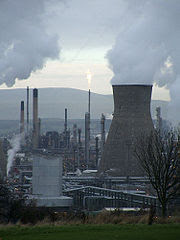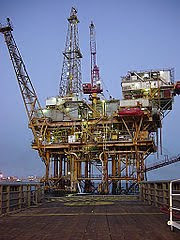Reactionary energies or gas energies are energies formed by natural coffers similar as anaerobic corruption of buried dead organisms.
These energies contain a high chance of carbon and hydrocarbons. reactionary energies range from unpredictable accoutrements with low carbonhydrogen rates like methane, to liquid petroleum to nonvolatile accoutrements composed of nearly pure carbon, like anthracite coal.
Methane can be set up in hydrocarbon fields, alone, associated with oil painting, or in the form of methane clathrates. It's generally accepted that they formed from the fossilized remains of dead shops and creatures by exposure to heat and pressure in the Earth's crust over hundreds of millions of times. It was estimated by the Energy Information Administration that in 2007 primary sources of energy comported of petroleum36.0, coal27.4, natural gas23.0, amounting to an86.4 share for fossil energies in primary energy consumption in the world.

Non-fossil sources in 2006 included hydroelectric6.3, nuclear8.5, and( geothermal, solar, drift, wind, wood, waste) amounting 0.9 percent. World energy consumption was growing about2.3 per time. reactionary energies arenon-renewable coffers because they take millions of times to form, and reserves are being depleted much briskly than new bones are being formed. The product and use of fossil energies raise environmental enterprises.
A global movement toward the generation of renewable energy is thus under way to help meet increased energy requirements. The burning of fossil energies produces around21.3 billion tonnes(21.3 gigatonnes) of carbon dioxide per time, but it's estimated that natural processes can only absorb about half of that quantum, so there's a net increase of10.65 billion tonnes of atmospheric carbon dioxide per time( one tonne of atmospheric carbon is original to44/12 or3.7 tonnes of carbon dioxide). Carbon dioxide is one of the hothouse feasts that enhances radiative forcing and contributes to global warming, causing the average face temperature of the Earth to rise in response, which climate scientists agree will beget major adverse goods.

Origin reactionary energies are formed by the anaerobic corruption of remains of organisms including phytoplankton and zooplankton that settled to the ocean( or lake) bottom in large amounts under anoxic conditions, millions of times agone Over geological time, this organic matter, mixed with slush, got buried under heavy layers of deposition.
There's a wide range of organic, or hydrocarbon, composites in any given energy admixture. The specific admixture of hydrocarbons gives a energy its characteristic parcels, similar as boiling point, melting point, viscosity, density, etc. Some energies like natural gas, for case, contain only veritably low boiling, gassy factors. Others similar as gasoline or diesel contain much advanced boiling factors. Terrestrial shops, on the other hand, tend to form coal. numerous of the coal fields date to the Carboniferous period of Earth's history.
significance An oil painting well in the Gulf of Mexico A petrochemical refinery in Grangemouth, Scotland, UKFossil energies are of great significance because they can be burned( oxidized to carbon dioxide and water), producing significant quantities of energy. The use of coal as a energy predates recorded history. marketable exploitation of petroleum, largely as a relief for canvases from beast sources( specially Goliath oil painting) for use in oil painting lights began in the nineteenth century. Natural gas, formerly burned - off as anun-needed derivate of petroleum product, is now considered a veritably precious resource. Heavy crude oil painting, which is much further thick than conventional crude oil painting, and navigator beach, where bitumen is set up mixed with beach and complexion, are getting more important as sources of reactionary energy. oil painting shale and analogous accoutrements are sedimentary jewels containing kerogen, a complex admixture of high- molecular weight organic composites, which yield synthetic crude oil painting when hotted ( pyrolyzed).
These accoutrements have yet to be exploited commercially. These energies are employed in internal combustion machines, reactionary energy power stations and other uses. previous to the ultimate half of the eighteenth century, windmills or watermills handed the energy demanded for assiduity similar as milling flour, sawing wood or pumping water, and burning wood or peat handed domestic heat. The wide- scale use of fossil energies, coal at first and petroleum latterly, to fire brume machines, enabled the Industrial Revolution. The invention of the internal combustion machine and its use in motorcars and exchanges greatly increased the demand for gasoline and diesel oil painting, both made from fossil energies. Other forms of transportation, railroads and aircraft also needed reactionary energies. The other major use for fossil energies is in generating electricity and the petrochemical assiduity. navigator, a leftover of petroleum birth, is used in construction of roads.
Limits and druthers Global reactionary carbon emigration by energy type, 1800- 2004 ADMain papers Peak oil painting and Hubbert peak proposition The principle of force and demand suggests that as hydrocarbon inventories dwindle, prices will rise. thus advanced prices will lead to increased volition, renewable energy inventories as preliminarily uneconomic sources come sufficiently provident to exploit. Artificial gasolines and other renewable energy sources presently bear more precious product and processing technologies than conventional petroleum reserves, but may come economically feasible in the near future. See Energy development. Different indispensable sources of energy include nuclear, hydroelectric, solar, wind, and geothermal. situations and flows Peak oil painting situations of primary energy sources are the reserves in the ground.
Overflows are product. The most important part of primary energy sources are the carbon grounded reactionary energy sources. oil painting, coal, and gas stood for79.6 of primary energy product during 2002( in million tonnes of oil painting fellow( mtoe))(34.923.521.2). situations( proved reserves) during 2005- 2007 oil painting 1,119- 1,317 billion barrels( 178- 209 billion m ³)( 13) Gas 6,183- 6,381 trillion boxy bases( 175- 181 trillion m ³)( 13), 1,161 billion barrel oil painting fellow( BBOE) Coal 997,748 million short tons( 905 billion tonnes)( 14), 4,416 BBOE Flows( diurnal product) during 2006 oil painting 84 million barrels per day( 13 million m ³)( 15) Gas 104,435 billion boxy bases( 2,960 billion m ³)( 16), 19 million barrels oil painting fellow per day( MBOED) Coal short tons( tonnes)( 17), 52 MBOED Times of product left in the ground with the most auspicious proved reserve estimates( Oil & Gas Journal, World Oil) oil painting 43 times( 43 times using situations and overflows over) Gas 167 times( 61 times using situations and overflows over) Coal 417 times( 148 times using situations and overflows over)
Note that this computation assumes that the product could be produced at a constant position for that number of times and that all of the proved reserves could be recovered. In reality, consumption of all three coffers has been adding . While this suggests that the resource will be used up more snappily, in reality, the product wind is much further akin to a bell wind. At some point in time, the product of each resource within an area, country, or encyclopedically will reach a maximum value, after which, the product will decline until it reaches a point where is no longer economically doable or physically possible to produce.
See Hubbert peak proposition for detail on this decline wind with regard to petroleum. Note also that proved reserve estimates don't include strategic reserves, which( encyclopedically) quantum to4.1 billion further barrels. The below discussion emphasizes worldwide energy balance. It's also precious to understand the rate of reserves to periodic consumption( R/ C) by region or country. For illustration, energy policy of the United Kingdom recognizes that Europe's R/ C value is3.0, veritably low by world norms, and exposes that region to energy vulnerability. Specific druthers fossil energies are a subject of violent debate worldwide. Environmental goods Environmental issues with energy In the United States, further than 90 of hothouse gas emigrations come from the combustion of fossil energies.
Combustion of fossil energies also produces other air adulterants, similar as nitrogen oxides, sulphur dioxide, unpredictable organic composites and heavy essence. According to Environment Canada The electricity sector is unique among artificial sectors in its veritably large donation to emigrations associated with nearly all air issues. Electricity generation produces a large share of Canadian nitrogen oxides and sulphur dioxide emigrations, which contribute to gauze and acid rain and the conformation of fine particulate matter. It's the largest unbridled artificial source of mercury emigrations in Canada.
Fossil energy- fired electric power shops also emit carbon dioxide, which may contribute to climate change. In addition, the sector has significant impacts on water and niche and species. In particular, hydro heads and transmission lines have significant goods on water and biodiversity. Carbon dioxide variations over the last 400,000 times, showing a rise since the artificialrevolution.According toU.S. Scientist Jerry Mahlman and USA Today Mahlman, who drafted the IPCC language used to define situations of scientific certainty, says the new report will lay the blame at the bases of fossil energies with virtual certainty, meaning 99 sure. His part in this time's trouble involved spending two months reviewing the further than 1,600 runners of exploration that went into the new assessment.
Combustion of fossil energies generates sulfuric, carbonic, and nitric acids, which fall to Earth as acid rain, impacting both natural areas and the erected terrain. Monuments and puppets made from marble and limestone are particularly vulnerable, as the acids dissolve calcium carbonate. reactionary energies also contain radioactive accoutrements , substantially uranium and thorium, which are released into the atmosphere. as important radioactivity into the atmosphere as the Three Mile Island incident. still, this radioactivity from coal burning is bitty at each source and has not shown to have any adverse effect on mortal physiology. Burning coal also generates large quantities of nethermost ash and fly ash.
These accoutrements are used in a wide variety of operations, exercising, for illustration, about 40 of the US product. Harvesting, processing, and distributing fossil energies can also produce environmental enterprises. Coal mining styles, particularly pinnacle junking and strip mining, have negative environmental impacts, and coastal oil painting drilling poses a hazard to submarine organisms. oil painting refineries also have negative environmental impacts, including air and water pollution. Transportation of coal requires the use of diesel- powered locomotives, while crude oil painting is generally transported by tanker vessels, each of which requires the combustion of fresh fossil energies.
Environmental regulation uses a variety of approaches to limit these emigrations, similar as command- and- control( which authorizations the quantum of pollution or the technology used), profitable impulses, or voluntary programs. An illustration of similar regulation in the USA is the EPA is enforcing programs to reduce airborne mercury emigrations. Under regulations issued in 2005, coal- fired power shops will need to reduce their emigrations by 70 percent by 2018. In profitable terms, pollution from fossil energies is regarded as a negative externality. Taxation is considered one way to make societal costs unequivocal, in order to' internalize' the cost of pollution. This aims to make fossil energies more precious, thereby reducing their use and the quantum of pollution associated with them, along with raising the finances necessary to offset these factors. Former CIA Director James Woolsey lately outlined the public security arguments in favor of moving down from fossil energies.
Visit Official Home Page




0 Comments